Physical Address
304 North Cardinal St.
Dorchester Center, MA 02124
Swallowing, the coordinated movement of liquids, purees, and/or solids, is a complex sensorimotor process that depends on integrated information from multiple levels of the central and peripheral nervous system. It involves complex excitatory and inhibitory signals from multiple regions of the cortex and subcortex, and ascending sensory signals from the oropharyngeal area that trigger the central pattern generator in the bulbar reticular formation. This makes up a network of premotor neurons and interneurons that drive motor neurons of swallowing in cranial nerves V, VII, IX, X, and XII. The muscles of the lips, submental muscle group, tongue, palate, larynx, pharynx, and esophagus that are innervated by these cranial nerves are then excited and inhibited sequentially to form an oral bolus and swallow. There are three phases of swallowing, (1) the oral phase, which is under voluntary control (preparing the food or liquid in the oral cavity to form a bolus on the tongue-including sucking liquids, manipulating soft boluses, chewing solid food, and moving or propelling the bolus posteriorly through the oral cavity); (2) the pharyngeal phase, which is under involuntary control (initiating the swallow and moving it through the pharynx); and (3) the esophageal phase, which is also under involuntary control (moving the bolus into and through the cervical and thoracic esophagus and into the stomach via esophageal peristalsis). When swallowing function is abnormal (dysphagic) due to developmental disability; neurologic disorders (e.g., cerebral palsy, meningitis, encephalopathy, traumatic brain injury, neuromuscular disease); factors affecting neuromuscular coordination (prematurity); complex medical conditions (e.g., heart disease, pulmonary disease, gastroesophageal reflux disease); structural abnormalities of the head and neck (e.g., cleft lip and/or palate, esophageal atresia, head and neck abnormalities); genetic syndromes (e.g., Pierre-Robin, Prader-Willi, Treacher-Collins); medication side effects; sensory issues as a primary cause or secondary to limited food availability in early development; behavioral factors; or social, emotional, and environmental issues; a radiologic study of swallowing function can assess and help therapists treat the dysphagia. Most swallowing disorders in infants and children are secondary to developmental disorders, of which cerebral palsy is the most common.
The Videofluoroscopic Swallow Study or VFSS is the radiographic study of deglutition performed in association with occupational therapists and/or speech pathologists, depending upon the institutional referral pattern. The primary purposes of the VFSS are (1) to assess the structure and function of swallowing and to assess the risk of aspiration; and (2) once a functional abnormality of swallowing is detected, to identify compensatory strategies and a management plan that enables the patient to feed functionally and safely. These strategies may include adjustments in bolus characteristics (e.g., volume or texture), method of presentation (cup, spoon, straw, suckle feeder, syringe), body posture or position, sensory input, or the use of active maneuvers to protect the airway (e.g., supraglottic swallow, Mendelssohn maneuver, coughing, and clearing the throat between swallows).
As a prerequisite to performing the VFSS, the patient's history related to feeding and associated clinical conditions should be obtained and include data about the acuity of the clinical complaint, the child's feeding history, ability to suck, use of utensils, positioning and irritability during and after feeding, usual appetite, and signs of fatigue during feeding. Having this history can help streamline the evaluation and limit the duration of the examination to limit radiation exposure. The historical review should also include review of prior radiologic studies that may have already been performed including prior VFSS studies, upper gastrointestinal series (GIs), chest radiographs, high resolution computed tomography (HRCT) of the chest, etc., which may show radiologic evidence of dysphagia such as aspiration on a prior VFSS or upper GI, or secondary signs of aspiration on a chest radiograph or HRCT such as right upper lobe and bibasilar lung disease pattern.
The initial step in the evaluation of swallowing is to assess the anatomic structures of the naso- and oropharynx. Note the presence of a nasoenteric tube or tracheostomy tube and realize that the presence of a nasoenteric feeding tube has been shown to have no significant effect on the results of the VFSS. For feeding, parents are asked to bring food and liquid that the child typically eats or drinks at home, as well as familiar utensils. The VFSS is then completed with this food or liquid mixed with contrast (usually barium). In some patients, flavoring can be added to the liquid to increase patient cooperation in swallowing although making sure not to modify the thickness of the standard thin and thickened liquids. The patient is placed in the true lateral position in a swallowing chair (or side-lying on the fluoroscopy table tilted at 15 degrees head up if neonate or small infant to simulate breast-feeding position) and is fed the liquid/contrast mixture of varying thickness by bottle with a nipple, sippy cup, cup with straw, or open cup depending on their level of development. Swallowing is evaluated in real time with video fluoroscopy (15–30 frames per second), examining mostly from the mouth through the cervical esophagus. At least one swallow should be followed to the gastroesophageal junction to detect any unexpected esophageal abnormality such as an unknown or recurrent H-type tracheoesophageal fistula or esophageal stricture that might occur in a patient with history of repaired esophageal atresia, a prominent vascular impression such as an aberrant subclavian artery (dysphagia lusoria) or esophageal achalasia in an older patient. Imaging in the frontal projection may be done after lateral imaging, sometimes using a basal or Towne view. This allows for evaluation of lateral wall movement, as well as correlation with the clinical evaluation of swallowing by fiberoptic endoscopic evaluation of swallowing, which is often performed as a complementary examination.
If the infant will not take liquid/contrast from the nipple, it can be carefully introduced into the baby's mouth with a blunt-tipped syringe (between the cheek and the lateral aspect of the teeth or gums) or a feeding tube can be inserted through the nipple ( e-Fig. 97.1 ) into the baby's mouth and controlled introduction of contrast under fluoroscopic guidance can be made to initiate swallowing. However, this type of “force-feeding” is artificial because it bypasses the oral phase of swallowing and so the results should be interpreted with caution. Force-feeding should be avoided and if a patient refuses to eat or drink; discontinuing the examination and performing when the infant or child is more cooperative is recommended for the best and most clinically relevant results. Contrast medium is mixed with increasingly thick food mixtures from puree to solid and swallowing of these are evaluated (if age-appropriate). Evaluation of the patient's ability to handle differently textured foods aids in planning appropriate diet to meet nutritional needs and for future therapy. If the patient needs a special diet or only eats certain foods, those can be brought to the examination and used. If aspiration is seen during the VFSS, the study is not usually discontinued. Rather, the therapist will modify feeding strategies to help the patient swallow without aspirating; for example, (1) pacing the swallow, allowing only several swallows with intervening breaks; (2) utilizing nipples with a smaller opening resulting in a slower flow rate; and (3) thickening the fluid. One or all of these strategies are sometimes utilized to obtain safe swallowing.
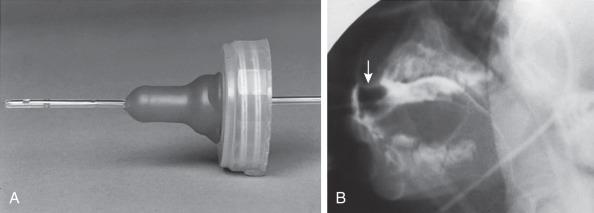
Typical abnormal findings in the oral phase of swallowing on a VFSS include (1) loss of food out of the mouth due to reduced lip closure, tongue thrust, and reduced tongue control; (2) piecemeal deglutition (requiring multiple swallows to clear the oral cavity of a single bolus) due to reduced tongue movements or strength; (3) prolonged oral transport (liquid >3 seconds) and (4) oral transport of puree with no bolus formation, both due to reduced tongue coordination; and (5) prolonged presence of material in valleculae or pyriform sinuses preinitiation due to prolonged delay in pharyngeal initiation of swallowing.
Typical abnormal findings in the pharyngeal phase of swallowing include (1) pharyngonasal backflow due to reduced velopharyngeal closure or incoordination of pharyngeal contraction ( Fig. 97.2 and e-Fig. 97.3 ); (2) laryngeal penetration due to reduced or delayed closure of airway entrance (laryngeal vestibule) ( Fig. 97.4 and ); (3) aspiration: (a) before swallow due to delayed swallow initiation, (b) during swallow due to incoordination of pharyngeal contraction and airway closure or vocal fold paresis or paralysis, (c) after swallow due to reduced pharyngeal pressure or contractions from residue; and/or (4) postswallow residue: (a) in valleculae due to reduced tongue base contraction, (b) in pyriform sinuses or posterior pharyngeal wall due to reduced submental muscle group and pharyngeal contraction.
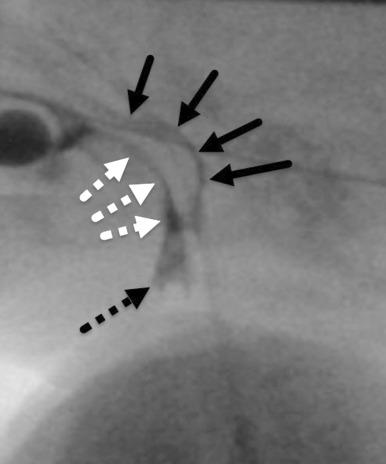
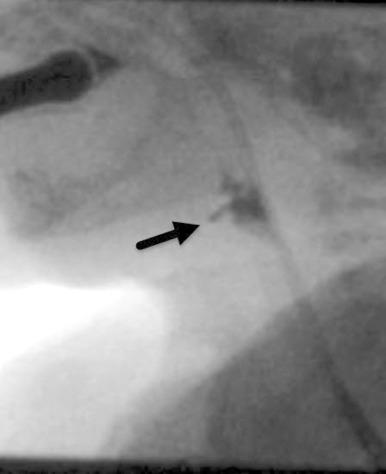
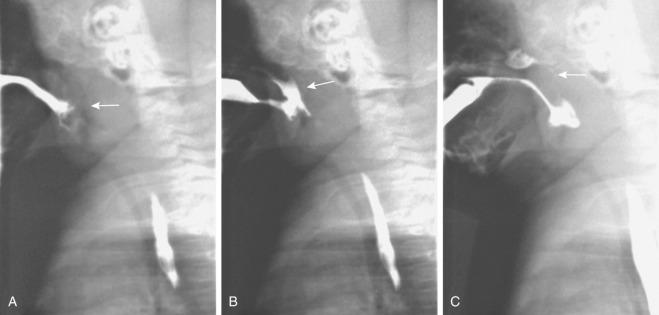
Typical abnormal findings in the esophageal phase of swallowing include (1) postswallow residue in the upper esophageal sphincter region due to reduced contraction of submental muscle group, tongue base, and reduced pharyngeal contractions and (2) prominence of or incomplete relaxation of the cricopharyngeus muscle (cricopharyngeal bar) due to reduced upper esophageal sphincter (UES) opening or premature UES closure.
The most common causes of swallowing dysfunction in pediatric patients include central neurologic dysfunction, congenital anomalies that cause anatomic abnormalities with mechanical interference in the swallowing apparatus, congenital and acquired retropharyngeal processes, and connective tissue disorders.
Cerebral palsy is the most common cause of swallowing dysfunction in infants and children. Other neuromuscular disorders to be considered are brainstem dysfunction, cranial nerve abnormalities, intracranial neoplasms, meningomyelocele, muscular dystrophies, and myasthenia gravis. Familial dysautonomia (Riley-Day syndrome) leads to autonomic dysfunction with esophageal dysmotility and frequent aspiration pneumonia. Abnormality of the neuromuscular mechanism elevating the soft palate (velopharyngeal closure) may lead to reflux of contrast material into the nasopharynx (pharyngonasal backflow or reflux), with subsequent pooling of contrast in the pharynx and potential aspiration into the airway. Abnormalities of other muscle groups lead to defective function of the epiglottis and upper esophageal sphincter, with aspiration into the airway being common.
The etiology of swallowing dysfunction is related to dysfunction in one of the three phases of swallowing: oral phase with inability to deliver the food into the mouth (e.g., poor suck); pharyngeal phase with failure to move the food through the pharynx, elevation of the soft palate and closure of the epiglottis; or in the upper esophageal phase, with abnormal coordination of relaxation and contraction phase of the UES as previously detailed. The coordination necessary to effect the swallowing process correctly is mediated through the cranial nerves responsible for both sensation and motor function, as well as osseous and muscular structures supplied by both the autonomic and voluntary nervous system. Thus depending on the level of the central nervous system (CNS) defect, one can predict which phase of swallowing will be most effected.
The severity of disordered swallowing and presence or absence of aspiration will depend on the level of neurologic deficit. Depending on the specific neurologic defect, any or all components of the swallowing mechanism may be affected. Symptoms may include pharyngonasal backflow, gagging, coughing and choking during feedings, recurrent pneumonia, malnutrition, and failure to thrive. However, in some patients at risk for disordered swallowing and aspiration, the gagging and coughing reflex may itself be inherently absent or secondarily impaired, and these patients are at risk to aspirate without the protective cough reflex (silent aspiration). Due to the risk of silent aspiration in these patients, VFSS should be performed to aid nutritional management and to help reduce aspiration where possible.
The abnormalities detected during VFSS will depend on the level of CNS defect. In upper cortical motor neuron dysfunction, oral phase dysfunction will dominate with loss of food from the mouth anteriorly, poor oral control of the bolus, fluid flowing off the tongue into the sulci of the mouth, and multiple small swallows required for a single bolus (piecemeal swallowing). In these patients, the pharyngeal phase is not as affected although if the oral phase of swallowing is markedly impaired, the pharyngeal phase will not be able to accommodate and contrast material may be seen within the nasopharynx or trachea ( Fig. 97.5 and ). Dysfunction in the pharyngeal phase may be related to brainstem dysfunction such as Chiari malformation, brainstem neoplasm, after resection of posterior fossa tumors, or demyelinating diseases involving brainstem structures. This may result in weak pharyngeal contraction or lack of adequate forward passage of pharyngeal contents resulting in pharyngeal residue or findings of a cricopharyngeal bar suggestive of cricopharyngeal achalasia. It is also important to note if the patient can spontaneously clear the residue by repetitive dry swallows and if a cough reflex is present during episodes of aspiration.
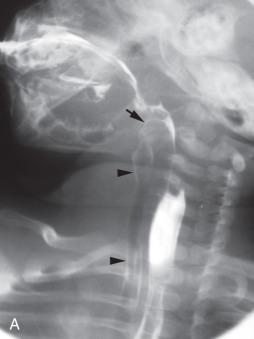
Become a Clinical Tree membership for Full access and enjoy Unlimited articles
If you are a member. Log in here